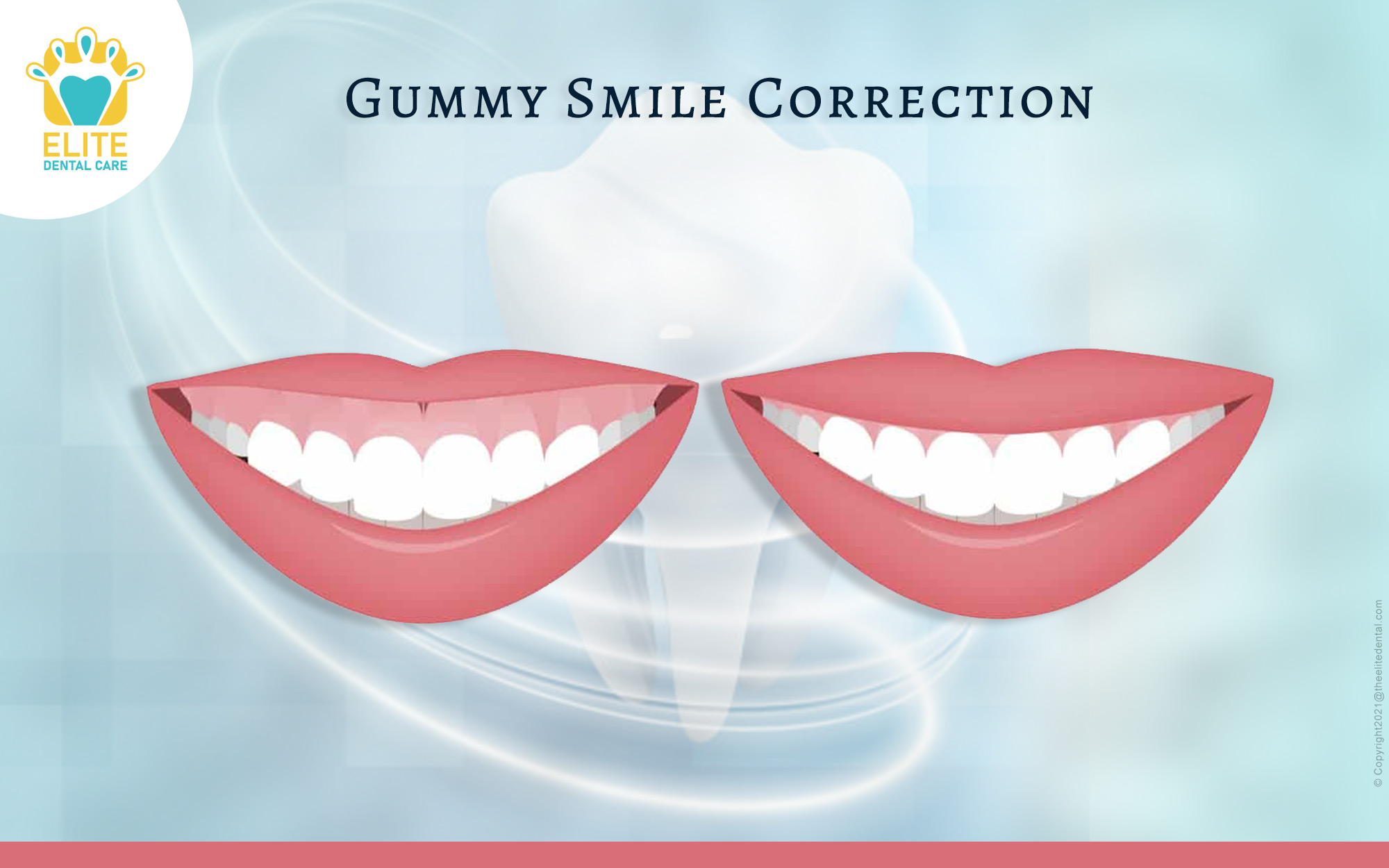
hygiene tipsoral healthRoot Canal TreatmentTeeth Whitening
edental
1 February 2022
Gummy Smile Correction
Correcting a gummy smile may be a freeing experience. You got it if you think you have a gummy smile. When you smile and realize your gums are overly large, it might come back to bother you. Many people’s largest cause of self-consciousness has been their gummy smile. And it’s not simply a passing feeling of self-consciousness; many people have admitted to being embarrassed to smile or laugh their whole lives.
Have you ever wished that your full smile could just expose your lovely teeth and not your gums? Have you ever attempted to hide your smile since your gums are so visible when you smile? There is, however, a solution to correct your gummy smile.
Gummy smiles are distinguished by an excessive show of gums when smiling. A typical smile shows around two-thirds to three-quarters of the teeth, with the rest hidden between the lips. The presence of more than 2-3mm of gum displayed as a continuous spectrum on speaking or regular smiling, on the other hand, is a gummy smile feature and may generate unaesthetic appearances. The prevalence of a gummy smile is more common in ladies than in males. It is also passed down through generations and has a genetic proclivity.
REASONS FOR GUMMY SMILE:
- Upper lip muscles that are strong
- Teeth that are crooked
- Teeth that are short/small
- Upper lip is too short
- Face vertical growth increased.
In all of the scenarios described above, there is an excessive show of gums or upper teeth, resulting in a very unattractive look that may have a social and psychological impact on a person. The good news is that it is treatable and can be returned to normalcy.
CORRECTION OF A GUMMY SMILE
The method for correcting a gummy smile is referred to as ‘Lip Repositioning Surgery.’
Lip repositioning surgery is a cosmetic procedure in which the lip is connected closer to the teeth so that the gums are not visible when smiling. After determining that you are medically fit for the operation, your dentist will set an appointment for you. After applying local anesthetic to the gums, your doctor will cut off the extra gum display and sew back the interior of the gums near to the teeth. The complete treatment would take between 30 and 40 minutes.
The results will be seen immediately, but care must be taken not to overstretch the muscles, which may lead the sutures to weaken or rupture. For the first 2-3 days following the surgery, a light and bland diet is recommended. Your doctor will give you a call after a week for an examination and to remove the sutures.
CROWNS OR VENEERS
If you don’t have any serious underlying concerns that are causing your gummy smile, veneers or crowns are a good treatment. Having a veneer or crown affixed to your teeth is merely cosmetic, therefore if you have an underlying problem that is creating your gummy smile, this will not alleviate any pain or suffering caused by those disorders.
For this potential treatment, your dentist or orthodontist will apply veneers or crowns to your teeth to make them look longer and bigger. This makes your teeth come off more proportional to your gums. This is a relatively non-invasive method of reducing the look of your gummy smile.
PROCESS INVOLVING CROWN LENGTHENING
If you’re considering a surgical treatment to address your gummy smile, a gingivectomy is one of the most common alternatives. A gingivectomy is a crown-lengthening surgery in which an orthodontist removes gum tissue from the tooth to expose more of the original tooth.
Whereas a veneer or crown will make your teeth look more proportional to your gums, a gingivectomy will reduce the quantity of gum tissue you have to make your natural teeth appear more proportionate. This is a more intrusive operation than having a veneer or crown, but it is still a minimally invasive orthodontic procedure in general. It is also known as gum reshaping surgery.
ORTHOGNATHIC SURGERY
If you have increased gingival show because of your jaw, your dentist or orthodontist may prescribe orthognathic treatment. The length of your upper and lower jaws will be balanced with this operation.
This treatment method necessitates much preparation. You may need to see an orthodontist as well as a maxillofacial surgeon. One or more scans of your mouth will most likely be performed to establish where your jaw has expanded too far. Before having jaw surgery, you may need to wear braces or other orthodontic equipment to ensure that your teeth and arches are properly aligned.
The cost of orthognathic surgery is significantly greater than that of less invasive treatments. If your insurance does not cover this treatment, it might cost you between $20,000 and $40,000.
However, if your surgery is medically required to avoid issues with your bite or jaw, your insurance may pay the expense.
BOTOX FOR THE CORRECTION OF GUMMY SMILES
By relaxing the muscles of your upper lip, Botox can assist to correct a gummy smile. Botox works by reducing muscular activity in the upper lip, which is actually a group of muscles. By injecting a little dose of botox into the muscle that elevates the lip, you can lessen the height of your lip when you smile.
Botox injection effects will be fully noticeable between 4-7 days, with results lasting up to 4-6 months. Once the benefits of Botox have worn off, it can be re-injected as required.
The advantage of Botox is that it is reversible and enables a person to see how their smile would appear before surgery; nevertheless, this is also its most significant negative. Botox for a gummy smile might be expensive to spend over the course of a lifetime.
CONTOURING OF THE GUMS WITH LASER
Laser gum contouring is comparable to gingivectomy, however unlike gingivectomy, this operation contours the gums and moves your gum line back with a laser. This operation, like a standard gingivectomy, is painless, reshapes the gum line, and is usually done for cosmetic and aesthetic reasons rather than for medical reasons. Laser gum contouring frequently removes more gum tissue than traditional gingivectomy, however the quantity removed varies based on your mouth and gum form.



